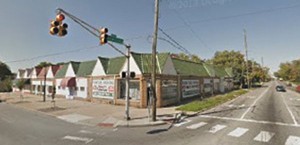For almost 90 years, storefronts at the northwest corner of Emerson Avenue and East 10th Street offered the surrounding community services from groceries to pharmaceuticals; from a haircut and a perm to family dining. Today, all that remains of a once vibrant commercial strip is a truncated site.
Indianapolis realtor Jacob Jacquart had seven Tudor style storerooms with half-timber gable dormers built on this corner of the Emerson Highlands Addition in the summer of 1926. He hired contractor Homer H. Negley to construct a complex that conformed to a description in an Indianapolis Star article in which “the trend in storeroom construction is toward more attractive design that will blend with the residential aspect of the neighborhood.” The building was built of brick with a flat roof and green tiled, sloped roof overhangs at a cost of $13,000 (2015: $176,294). These materials may have been used because Jacquart at one time had operated tile and brick factories in Illinois.
The little shopping area opened in the fall of 1926 with a drug store and an A & P grocery store along the 10th Street side. In the other storefronts along the side facing Emerson Avenue were a meat shop, a bakery, and a fruit store. The business complex would also soon boast a barber shop and a cleaners in two initially vacant storefronts on the Emerson Avenue side. Within five years, the site was such a commercial success that additional Tudor style storefronts were built to the west of the complex on 10th Street. These new additions were of the same brick construction, but with red tiled, sloped roof overhangs.
Over the years storefronts changed, but the neon sign over the entrance to the corner storefront consistently announced the Emerson Pharmacy until the late 1960s. For two decades following World War II, the family-owned Emerten Restaurant facing 10th Street was a popular eatery for breakfast, lunch, and dinner. The favorite breakfast item was hotcakes with buttermilk biscuits, and a complete chicken dinner could be had for 85ȼ (2015: $6.80) in 1961.
Storefronts along Emerson Avenue catered to tots and teens, as well as older folks. For over 50 years, Joe’s Shoe Repair looked after the neighborhood’s heels and mended its soles, and through the years of the Great Depression and World War II the Emerson Heights Free Kindergarten helped to form future citizens. When a proposed café in a 10th Street storefront sought to sell alcohol, supposedly this led to the eviction of the kindergarten in 1946 and brought the neighborhood together to form the Emerson Heights Civic League, “dedicated to the principle of neighborhood control over neighborhood conditions.” In another Emerson Avenue storefront, the post-World War II teen could find That Old Black Magic vinyl at the Della Penna Record Shop. Frank Sinatra favorites — The Anniversary Song — along with the Ink Spots — Sweetest Dreams — and other popular hits were only 63 cents (2015: $7.73). For almost 60 years, from barbers Ora Devoe to Tom Bellamy, skilled hands kept eastsiders trim with a shave and a haircut.
By the time our nation was celebrating its bicentennial, fewer of the storefronts in this neighborhood commercial strip contained businesses offering daily services for the community while more of the storefronts contained specialty businesses. A telephone answering service occupied the premier corner location, while one Emerson Avenue storefront was Lyday’s Upholstery and two others housed the door repair firm, Door Closer Service Co. Wedged in between these businesses was the office of general practitioner Dr. James B. Warriner. A 10th Street storefront had been transformed into a cocktail lounge called The Dungeon that offered “go-go girls” for entertainment.
The summer of 2014 saw most of these storefronts being razed. Today, all that remains of this aging complex are the three doors at the west end of the complex facing 10th Street, which came down in a windstorm in 2015. Although it has been said that this corner “brick building with a clay-tile roof bears no historical significance,” it was one of two early examples of commercial development in Indianapolis that was designed to blend with the residential aspect of the neighborhood. The other was at 16th and Meridian Streets. Now both of these early architectural styles are gone forever.



